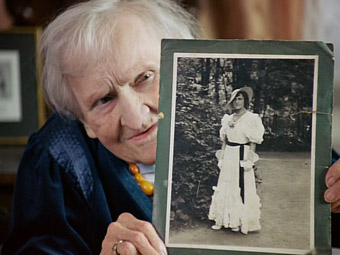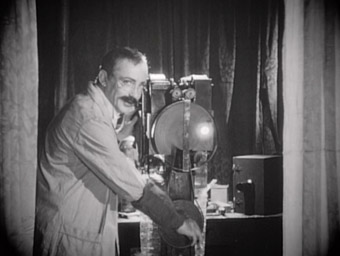|
The history of several
countries includes individuals
with a viable claim to have been at least partially responsible
for the birth of cinema, names that are often forgotten
in the discussion surrounding the Lumière Brothers
and Thomas Edison. We in Britain have William Friese-Green,
an inventor whose pioneering work with moving picture and
projection systems too often goes unmentioned and is even
the subject of dispute in some circles, but was canonised
by John Boulting in his 1951 biographical feature The
Magic Box.
Friese-Green's
German equivalent has to be Max Skladanowsky, who with the
assistance of his brothers Eugen and Emil, invented an early
movie projector known a the Bioskop, which was first demonstrated
to a public audience on 1 November 1895, a good two months
before the Lumière Brothers wowed the world with
their own technically superior projection system, the cinematographe.
Yet even in his home country, the name of Max Skladanowsky
is largely unknown. In 1995, director Wim Wenders, working
with students from the Munich Academy for Television and
Film, set about putting that right. The result was Die
Gebrüder Skladanowsky (The Brothers
Skladanowsky, known in the UK and the US as A
Trick of the Light), a warm, lively and affectionate
tribute to these home-grown film pioneers.

Built
around an interview with Skladanowsky's daughter Gertrude,
who was a still sharp 91 at the time of shooting, the film
interweaves her recollections with silent movie-style recreations
of the story of the Bioskop's development, old-school trick
photography superimpositions and some enjoyable film-within-a-film
game-playing. The silent movie sequences in particular are
winningly executed, Jürgen Jürges' spot-on cinematography
(these sequences were apparently shot entirely on an authentic
hand-cranked camera) and Laurent Petitgand's cheerful, piano-led
score really capturing the feel of early cinema, while the
actors, led by a not instantly recognisable Udo Kier
(it's that moustache and those glasses), strike just the
right note in the slightly exaggerated physicality of their
performances. The opening sequence in particular, which
details the Bioskop's invention and is enthusiastically
narrated by young Gertrude-as-child actress Nadine Buettner,
is a delight.
Informative
and entertaining, Die Gebrüder Skladanowsky
is film history seen through filmmakers' eyes, and it seems
only appropriate that a story of early cinema should be
told in such a fashion. Carrying a dedication to all of
cinema's forgotten pioneers, the film reaffirms the Skladanowsky
brothers' contribution for a wider international audience. If the details of the first public screening are to
be believed, then they can still lay claim to having been
the first filmmakers to do a retake and use a body double,
and, many decades before the likes of Jackie Chan and It'll
Be Alright on the Night, were responsible for showing
the first ever film outtakes.
The film's only questionable over-indulgence has to be the
end credits, which run for over ten minutes and are intercut
with extracts of the film and some unused footage and are
followed by five minutes of the same short Bioskop loop,
just to recreate the experience for a modern audience. The
extra footage does include a telling response to the silent
sequences from the real Gertrude Skladanowsky, which is
worth hanging around for.
Framed
1.33:1, the image is a blend of colour and monochrome 35mm
and a rather nicely faked Old Movie sequences, shot on a
hand-cranked camera. The transfer quality is best judged
by the colour interview material, and this is first rate,
displaying very good colour, sharpness and contrast, and
has that special film quality that high def still has yet
to quite capture. The slightly lower contrast and definition
on the silent movie recreations (they're still pretty damned
good) is inevitable and appropriate.

The
mono Dolby 2.0 and surround 5.1 soundtracks are very similar,
with not real surround work on the 5.1, although it is slightly
louder than the 2.0.
None.
Once again we lose out to the US release, which at least
has a Wenders commentary.
A
fascinating slice of film history presented in a playful
manner and thoroughly engaging manner, very much the work
of a man in love with cinema, a love that he most effectively
communicates here. It's a very welcome inclusion in the
Wim Wenders Collection, even if the credits are
too long.
|